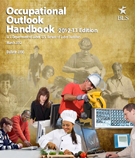October 16, 2012
Students who graduated from high school in the late 1990s and early 2000s took more rigorous mathematics courses than did students who graduated from high school in the mid to late 1970s and early 1980s.
Full Text »
Recent TED articles

|
Wife's employment and allocation of resources in families with children
Ann C. Foster and Craig J. Kreisler
Summary |
Full text in PDF
The behavior of the Producer Price Index in a global economy
Maureen P. Doherty
Summary |
Full text in PDF
Job openings and hires continue to show modest changes in 2011
Guy L. Podgornik
Summary |
Full text in PDF
|
Since the 1980s, school systems in the United States have made efforts to increase the rigor of high school coursework. Following the 1983 report, “A Nation at Risk,” which decried the status of primary and secondary education in the United States, most states instituted tougher graduation requirements. Recent reforms have made higher level courses mandatory for graduation.
Read full article | Download PDF
Looking back at Compensation and Working Conditions
Test your knowledge
-
Complete the statement with foreign born or native born:
In 2011, there were 24.4 million foreign-born persons (persons who reside in the United States but who were born outside the country or one of its outlying areas to parents who were not U.S. citizens) in the U.S. labor force. The unemployment rate for the ____________ was 9.1 percent in 2011; the jobless rate of the ____________ was 8.9 percent. Overall, the unemployment rates of the ____________ in younger age groups (ages 16 to 34) tend to be lower than the jobless rates for the ____________. Among older workers (ages 35 and up), unemployment rates of the ____________ tend to be higher than for the ____________.
Hint:
Employment status of the foreign-born and native-born by age, 2011.
-
Complete the statement with the correct occupations from the list:
In 2011, women accounted for 47 percent of all employed persons 16 years of age and older. The share of women in specific occupations varied: 14 percent of ____________ and 34 percent of ____________ were women, whereas 61 percent of ____________ and 82 percent of ____________ were women.
- accountants and auditors
- architects and engineers
- elementary and middle school teachers
- physicians and surgeons
Hint:
Women as a percent of total employed in selected occupations, 2011.
More Quiz questions »



